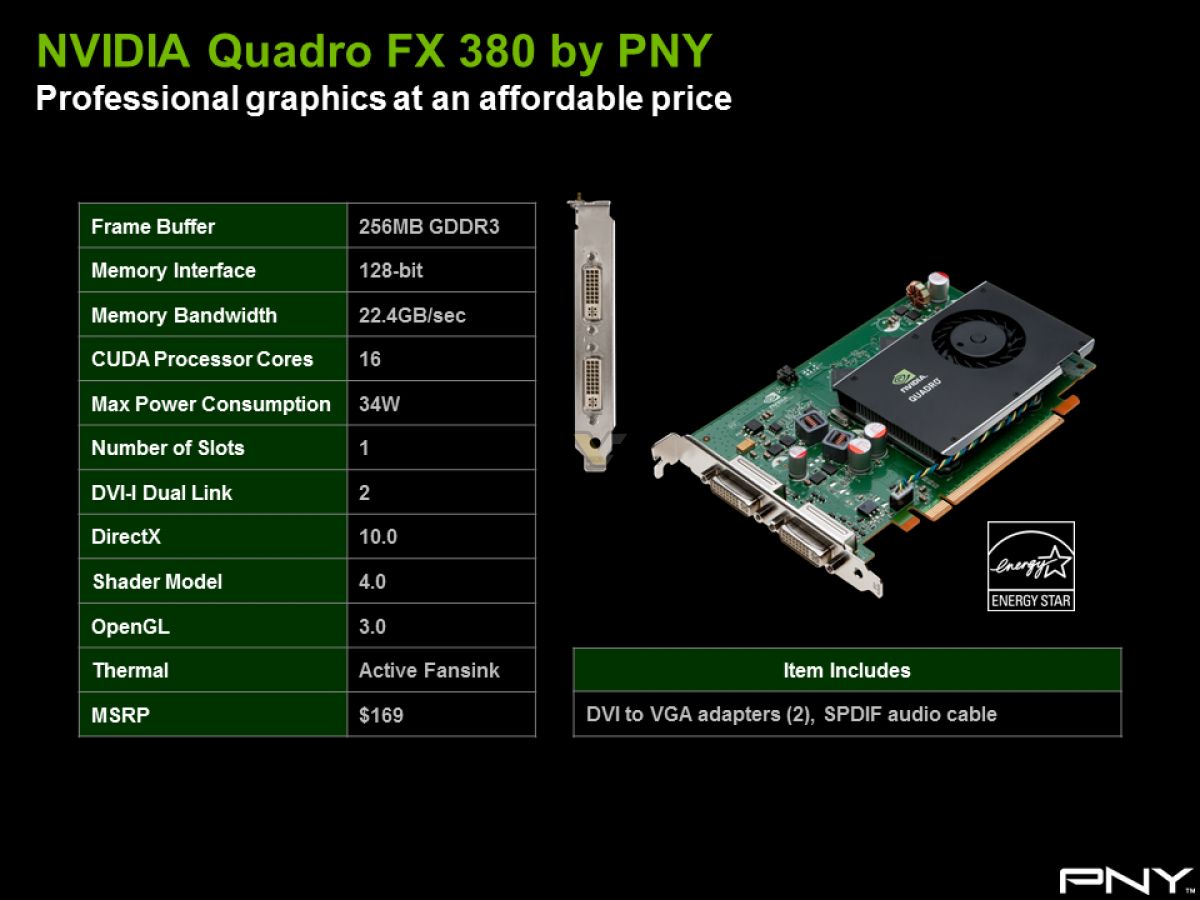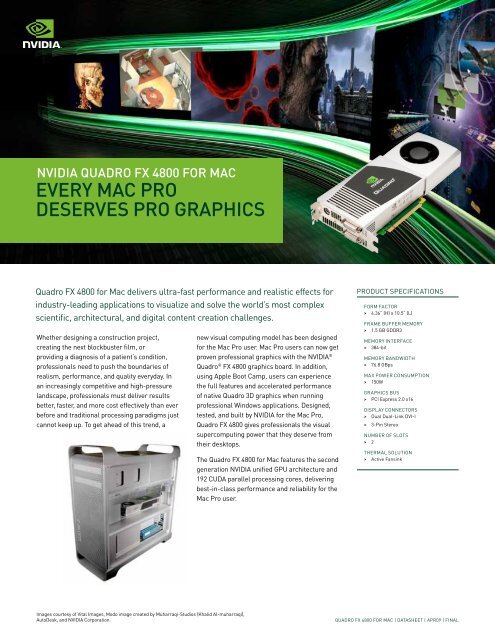Quadro 4000 slave = Radeon HD 5770 in slot one connected to display with NVIDIA Quadro 4000 for Mac in second slot with no display attached Quadro 4000 = NVIDIA Quadro 4000 for Mac Quadro FX 4800 = NVIDIA Quadro FX 4800 (Mac edition) GeForce GTX285 = NVIDIA GeForce GTX 285 (Mac edition) Radeon 5870 = ATI Radeon HD 5870 (CTO option for 2010 Mac Pro). The Quadro FX 4800 ultra-high-end solution is now available for the Mac Pro, giving researchers, digital artists, medical scientists and other professionals visual computing from their desktops. Apple Footer. This site contains user submitted content, comments.
Has Bare Feats helped you? How about donating to Bare Feats? feed |
| INDEX of recent articles or..
|
Nvidia Quadro 4800 Driver
For anyone who does 3D graphics, the high-end NVIDIA Quadro cards are the shiniest of red bicycles. At the top-end, they’ve got more memory than most gaming cards, but they've got a price to match their premium features. At $1799 retail, the Quadro FX 4800 Mac Edition is over $1300 more than the 1GB Geforce GTX 285 and is the only Quadro option available to Mac users. Considering the lack of reviews by 3D professionals who know how to test the card, that’s an expensive leap of faith that a potential customer would have to make. As someone who bought a Quadro FX 5600 for one of my older Mac Pros and Maya, that leap turned out to be quite an expensive letdown. So we thought we’d take another look at the faster Quadro FX 4800 to see if much has changed.
One thing has changed since then: NVIDIA has taken over official support of the Quadro cards and the drivers. Previously, the Quadro was supported by Apple, and while it was obvious NVIDIA had a hand in driver development, it was anyone’s guess as to who was responsible for the lackluster speed. Since the Quadro cards are all about drivers, giving NVIDIA some time to get the Quadro up to speed on the Linux and Windows sides seemed only fair.
I want to thank the people at NVIDIA for sending me the card, but also for their patience; we pushed this review back a few months since it was clear that OS X 10.6’s arrival would have dated the review immediately. Then we had to wait some more because OS X 10.6.0 had OpenGL problems with Maya and the Radeon 4870’s OpenCL was half-broken. We couldn’t have benchmarked the card properly until those were fixed with 10.6.2. So here we are.
Test hardware
- NVIDIA Quadro FX 4800 Mac Edition
- CUDA Cores: 192
- Memory Size Total: 1.5GB
- Memory Interface: 384-bit
- Memory Bandwidth: 76.8GB/sec
Test System
- Dual quad Nehalem Mac Pro 2.66 GHz
- 24GB RAM
- Dual 1920x1200 screens
- OCZ Vertex 120GB SSD startup disk
Test software
- OS X 10.6.2 and latest built-in Quadro FX 4800 driver
- Boot Camp 3 drivers with Windows Vista Ultimate 64-bit
- NVIDIA Quadro driver 1.9.1 64-bit
Nvidia Quadro Fx 4800 Mac Pro 1.1
All tests were performed running the 64-bit OS X kernel and drivers, except for CUDA tests, since CUDA is currently 32-bit only.
How the Quadro compares to a gaming card
For those new to the benefits offered by a Quadro card, there are a number of things that differ from the Geforce 200 series part that the Quadro is based on. While it’s true that the Quadro has fewer CUDA cores and a lower clock speed than the eVGA Geforce GTX 285, it has a long list of benefits:
- True quad-buffered 3D output
- 128-bit color precision
- 3D volumetric texture support
- 12 pixels per clock rendering engine
- 16 textures per pixel in fragment programs
- Window ID clipping functionality
- Unlimited fragment instruction
- Unlimited vertex instruction
- Hardware accelerated line stippling
- Hardware accelerated antialiased points and lines
- Hardware accelerated two-sided lighting
- Hardware accelerated clipping planes
Some of these features can add a bit of performance to programs that use them, but the major benefit to this card is its quad-buffered 3D output port. If you use a scientific application like Osirix or 3D animation package like Maya with a 3D-capable display or specialized 3D glasses, the Quadro is the only way to view that 3D output on the Mac. Unfortunately, I don’t have a setup capable of displaying 3D output so I couldn’t test it for myself.
For OS X’s GPU-reliant Aqua interface and Core Image, the Quadro doesn’t offer any benefit over the GTX 285, because the latter has more memory bandwidth (159GB/sec vs. the 4800’s 76.8GB/sec). The Quadro FX 4800 is capable of 10-bits-per-channel output, but the Mac edition only has dual-link DVI outputs, so there’s no way to harness this color power. The PC version has two 10-bit DisplayPort outputs so NVIDIA opted for compatibility over pro features on the Mac version. I’ve never been a fan of Apple’s obscure mini DisplayPort, but if it was used instead of DVI, this could have been the only card capable of 10-bits per channel output on OS X. The 4800 does support 10-bit grayscale output over DVI though, which is popular in medical imaging. If you’re hunting for tumors, you need all the help you can get.
The Potential Draw: CUDA for Video Professionals
Given that the advantages listed above appeal to a very small segment of users, NVIDIA has been working on CUDA software for professionals to drive the Quadro sales. The CUDA-based Elemental Accelerator H.264 video encoder is one of these ventures, and at $499, it is definitely priced for professionals. It only works with Quadro cards and the Adobe CS4 Suite of video applications, so that adds a further premium to the software price. Nevertheless, H.264 compression for Blu-ray is very time consuming, so the benefits of the Quadro and CUDA could be significant for video professionals, many of whom use Macs.
Getting the Elemental package running is very straightforward: install the bundle for Adobe’s suite and you’re set. The next time you launch Premiere or Adobe Media Encoder, you’ll have a new output option:
If you’re thinking that you can just install the bundle and run it on another CUDA-capable NVIDIA card, think again. It just crashes Adobe Media Encoder.
Nvidia Quadro Fx 4800 Specifications

Quadro Fx 4800 Mac Rom
From there, you can further customize your output options as with any other encoder:
The Elemental Accelerator also GPU-accelerates audio encoding:

Nvidia Quadro Fx 4800
Video options include the standard CBR/VBR output, 2-pass encoding and CABAC entropy encoding. The output options are limited but adequate: Encore-compatible Blu-ray H.264 stream output with separate audio file or multiplexed MP4 or MPEG2 containers. Be careful if you enable CABAC, since many devices like iPhones can't handle this decoding. The 2.1-profile muxed MP4s played fine on my iPhone 3G.